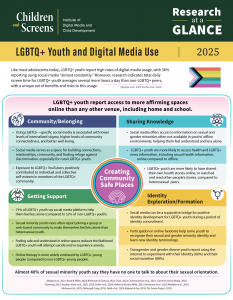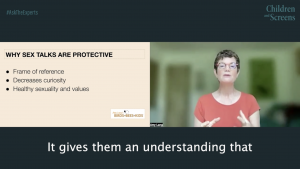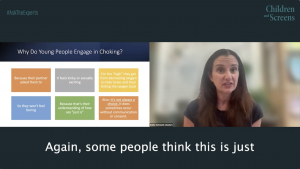 For LGBTQ+ youth, online spaces can provide opportunities for support, connection, and health information that they may not have access to offline. Yet these environments also come with heightened risks, including cyberbullying, discrimination and other threats to their well-being.
For LGBTQ+ youth, online spaces can provide opportunities for support, connection, and health information that they may not have access to offline. Yet these environments also come with heightened risks, including cyberbullying, discrimination and other threats to their well-being.
Children and Screens’ latest Research-at-a-Glance on “LGBTQ+ Youth and Digital Media Use” offers a vibrant two-page snapshot of current research on LGBTQ+ youths’ digital media use, including how their online experiences compare to non-LGBTQ+ peers, and the unique benefits (and risks) they face in digital media environments.
Abreu, R. L., & Kenny, M. C. (2018). Cyberbullying and LGBTQ youth: A systematic literature review and recommendations for prevention and intervention. Journal of Child & Adolescent Trauma, 11, 81-97.
Angoff, H.D., & Barnhart, W.R. (2021). Heterosexual youth from an intersectional perspective: Findings from the 2017 National Youth Risk Behavior Survey. Journal of School Violence, 20(3), 274-286. https://doi.org/10.1080/15388220.2021.1879099
Berger, M. N., Taba, M., Marino, J. L., Lim, M. S. C., Cooper, S. C., Lewis, L., Albury, K., Chung, K. S. K., Bateson, D., & Skinner, S. R. (2021). Social media’s role in support networks among LGBTQ adolescents: a qualitative study. Sexual Health (14485028), 18(5), 421–431. https://doi-org.ezproxy.msvu.ca/10.1071/SH21110
Bond, B. J., & Miller, B. (2024). YouTube as my space: The relationships between YouTube, social connectedness, and (collective) self-esteem among LGBTQ individuals. New Media & Society, 26(1), 513-533.
Brinkman, L., & Francot, R. (2022). Developing a resilient sexual and gender minority identity online: The importance of social media for youth before coming out. In LGBT+ Communities-Creating Spaces of Identity. IntechOpen. https://doi.org/10.5772/intechopen.108208
Chan, R.C.H. (2023). Benefits and risks of LGBT social media use for sexual and gender minority individuals: An investigation of psychosocial mechanisms of LGBT social media use and well-being. Computers in Human Behavior, 139. https://doi.org/10.1016/j.chb.2022.107531
Charmaraman, L., Hodes, R., & Richer, A. M. (2021). Young sexual minority adolescent experiences of self-expression and isolation on social media: Cross-sectional survey study. JMIR mental health, 8(9), e26207. https://doi.org/10.2196/26207
Common Sense Media, Hopelab. (2024). Getting Help Online: How Young People Find, Evaluate, and Use Mental Health Apps, Online Therapy, and Behavioral Health Information. https://www.commonsensemedia.org/sites/default/files/research/report/2024-getting-help-online-hopelab-report_final-release-for-web.pdf
Downing, G. (2013). Virtual youth: non-heterosexual young people’s use of the internet to negotiate their identities and socio-sexual relations. Children’s Geographies, 11(1), 44-58. https://doi.org/10.1080/14733285.2013.743280
Escobar-Viera, C. G., Choukas-Bradley, S., Sidani, J., Maheux, A. J., Roberts, S. R., & Rollman, B. L. (2022). Examining social media experiences and attitudes toward technology-based interventions for reducing social isolation among LGBTQ youth living in rural United States: an online qualitative study. Frontiers in Digital Health, 4, 900695.
Escobar-Viera, C. G., Porta, G., Coulter, R. W. S., Martina, J., Goldbach, J., & Rollman, B. L. (2023). A chatbot-delivered intervention for optimizing social media use and reducing perceived isolation among rural-living LGBTQ+ youth: Development, acceptability, usability, satisfaction, and utility. Internet interventions, 34, 100668. https://doi-org.ezproxy.msvu.ca/10.1016/j.invent.2023.100668
Fisher, C. B., Tao, X., & Ford, M. (2024). Social media: A double-edged sword for LGBTQ+ youth. Computers in Human Behavior, 156, 108194.
Gámez-Guadix, M., & Incera, D. (2021). Homophobia is online: Sexual victimization and risks on the internet and mental health among bisexual, homosexual, pansexual, asexual, and queer adolescents. Computers in human behavior, 119, 106728.
Herrmann, L., Bindt, C., Hohmann, S., & Becker-Hebly, I. (2023). Social media use and experiences among transgender and gender diverse adolescents. International Journal of Transgender Health, 25(1), 36–49. https://doi.org/10.1080/26895269.2023.2252410
Hiebert, A., & Kortes-Miller, K. (2021). Finding home in online community: exploring TikTok as a support for gender and sexual minority youth throughout COVID-19. Journal of LGBT Youth, 20(4), 800–817. https://doi.org/10.1080/19361653.2021.2009953
Kahle, L. (2020). Are Sexual Minorities More at Risk? Bullying Victimization Among Lesbian, Gay, Bisexual, and Questioning Youth. Journal of Interpersonal Violence, 35(21-22), 4960-4978. https://doi.org/10.1177/0886260517718830
Khanna, N., Maxwell, E., & Craig, W. (2023, March). Examining Key Populations in the Context of Implementing Cyberbullying Prevention and Intervention Initiatives. Public Safety Canada. https://www.publicsafety.gc.ca/cnt/rsrcs/pblctns/2023-r006/index-en.aspx#s3.3
Madden, M., Calvin, A., & Hasse, A. (2024). A Double-Edged Sword: How Diverse Communities of Young People Think About the Multifaceted Relationship Between Social Media and Mental Health. Common Sense Media. https://www.commonsensemedia.org/research/double-edged-sword-how-diverse-communities-of-young-people-think-about-social-media-and-mental-health
McInroy, L. B., McCloskey, R. J., Craig, S. L., & Eaton, A. D. (2019). LGBTQ+ Youths’ Community Engagement and Resource Seeking Online versus Offline. Journal of Technology in Human Services, 37(4), 315–333. https://doi.org/10.1080/15228835.2019.1617823
McInroy, L. B., Beer, O. W., Scheadler, T. R., Craig, S. L., & Eaton, A. D. (2024). Exploring the psychological and physiological impacts of digital microaggressions and hostile online climates on LGBTQ+ youth. Current Psychology, 43(3), 2586-2596. https://doi.org/10.1007/s12144-023-04435-1
McInroy, L. B., & Craig, S. L. (2018). Online fandom, identity milestones, and self-identification of sexual/gender minority youth. Journal of LGBT Youth, 15(3), 179–196. https://doi.org/10.1080/19361653.2018.1459220
Nagata, J. M., Balasubramanian, P., Iyra, P., Ganson, K. T., Testa, A., He, J., Glidden, D. V., & Baker, F. C. (2024). Screen use in transgender and gender-questioning adolescents: Findings from the Adolescent Brain Cognitive Development (ABCD) Study. Annals of epidemiology, 95, 6–11. https://doi.org/10.1016/j.annepidem.2024.04.013
Nagata, J. M., Lee, C. M., Yang, J., Al-Shoaibi, A. A. A., Ganson, K. T., Testa, A., & Jackson, D. B. (2023). Associations between sexual orientation and early adolescent screen use: findings from the Adolescent Brain Cognitive Development (ABCD) Study. Annals of epidemiology, 82, 54–58.e1. https://doi.org/10.1016/j.annepidem.2023.03.004
Nath, R., Matthews, D.D., DeChants, J.P., Hobaica, S., Clark, C.M., Taylor, A.B., Muñoz, G. (2024). 2024 U.S. National Survey on the Mental Health of LGBTQ+ Young People. The Trevor Project. www.thetrevorproject.org/survey-2024
Pagliaccio, D., Tran, K. T., Visoki, E., DiDomenico, G. E., Auerbach, R. P., & Barzilay, R. (2024). Probing the digital exposome: associations of social media use patterns with youth mental health. NPP – digital psychiatry and neuroscience, 2, 5. https://doi.org/10.1038/s44277-024-00006-9
Parent, M. C., Bond, B. J., Wille, L., & Green, A. E. (2024). Parasocial relationships, AI chatbots, and joyful online interactions among a diverse sample of LGBTQ+ young people. Hopelab. https://assets.hopelab.org/wp-content/uploads/2024/09/HL_ParasocialRelationships_report_FINALpdf.pdf
Rideout, V., & Fox, S. (2018). Digital Health Practices, Social Media Use, and Mental Well-Being Among Teens and Young Adults in the U.S. https://hopelab.org/reports/pdf/a-national-survey-by-hopelab-and-well-being-trust-2018.pdf
Tao, X., & Fisher, C. (2023). Associations among web-based civic engagement and discrimination, web-based social support, and mental health and substance use risk among LGBT youth: cross-sectional survey study. Journal of Medical Internet Research, 25, e46604. https://doi.org/10.2196/46604
The Trevor Project. (2023). Research Brief: LGBTQ Young People of Color in Online Spaces. The Trevor Project. https://www.thetrevorproject.org/wp-content/uploads/2023/07/The-Trevor-Project_LGBTQ-Young-People-of-Color-in-Online-Spaces.pdf
Thorn. (2024). Youth Perspectives on Online Safety, 2023. Available at: https://info.thorn.org/hubfs/Research/ Thorn_23_YouthMonitoring_Report.pdf
Ybarra, M. L., Mitchell, K. J., Palmer, N. A., & Reisner, S. L. (2015). Online social support as a buffer against online and offline peer and sexual victimization among US LGBT and non-LGBT youth. Child Abuse & Neglect, 39, 123-136. https://doi.org/10.1016/j.chiabu.2014.08.006




